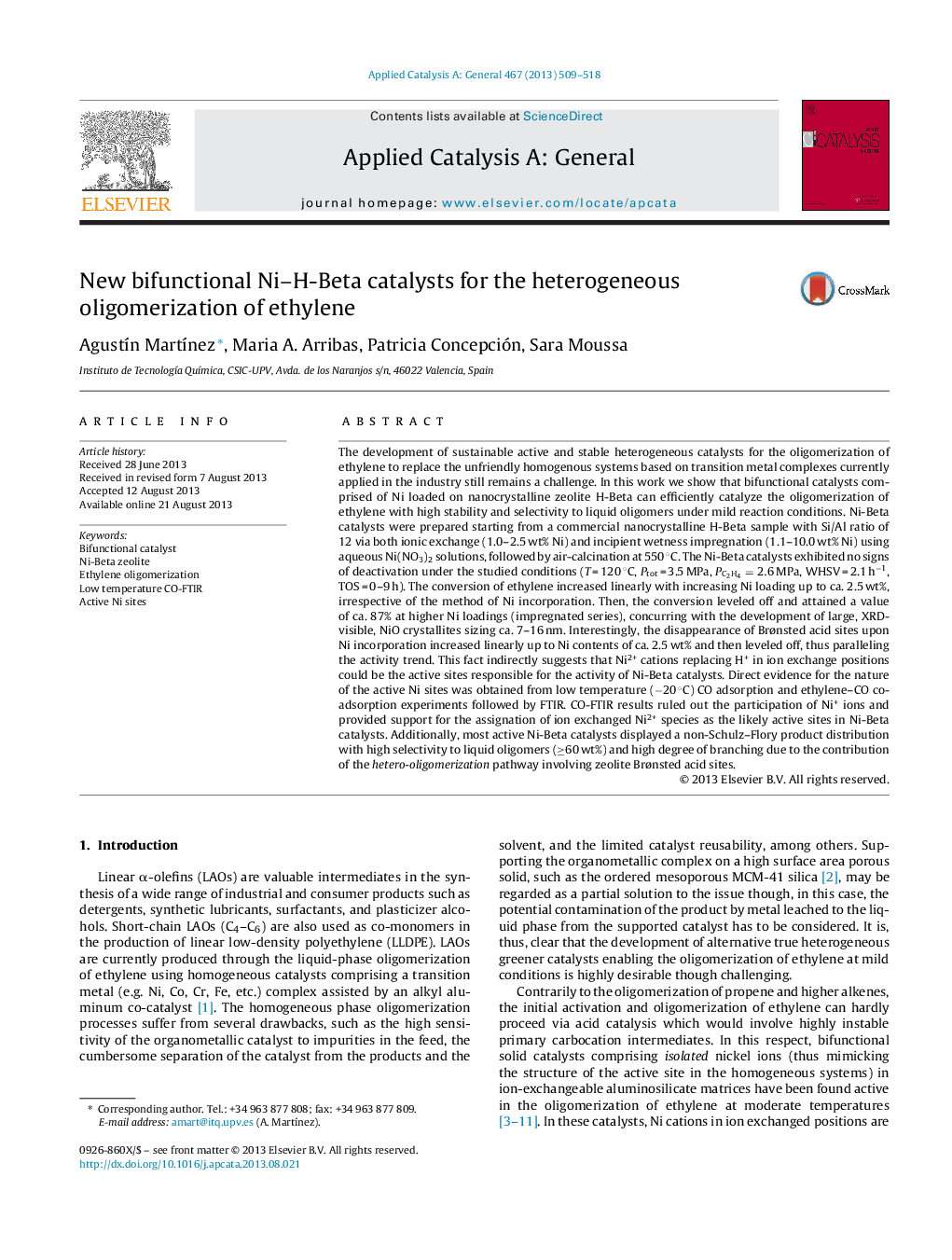| کد مقاله | کد نشریه | سال انتشار | مقاله انگلیسی | نسخه تمام متن |
|---|---|---|---|---|
| 40087 | 45843 | 2013 | 10 صفحه PDF | دانلود رایگان |

• Bifunctional Ni-Beta catalysts are active and stable in ethylene oligomerization.
• Ni sites predominantly produce butenes and, to a lesser extent, hexenes and octenes.
• Branched C5+ alkenes formed by secondary oligomerization on Brønsted acid sites.
• Based on CO-FTIR, Ni2+ cations at exchange sites are proposed as Ni active sites.
The development of sustainable active and stable heterogeneous catalysts for the oligomerization of ethylene to replace the unfriendly homogenous systems based on transition metal complexes currently applied in the industry still remains a challenge. In this work we show that bifunctional catalysts comprised of Ni loaded on nanocrystalline zeolite H-Beta can efficiently catalyze the oligomerization of ethylene with high stability and selectivity to liquid oligomers under mild reaction conditions. Ni-Beta catalysts were prepared starting from a commercial nanocrystalline H-Beta sample with Si/Al ratio of 12 via both ionic exchange (1.0–2.5 wt% Ni) and incipient wetness impregnation (1.1–10.0 wt% Ni) using aqueous Ni(NO3)2 solutions, followed by air-calcination at 550 °C. The Ni-Beta catalysts exhibited no signs of deactivation under the studied conditions (T = 120 °C, Ptot = 3.5 MPa, PC2H4=2.6 MPaPC2H4=2.6 MPa, WHSV = 2.1 h−1, TOS = 0–9 h). The conversion of ethylene increased linearly with increasing Ni loading up to ca. 2.5 wt%, irrespective of the method of Ni incorporation. Then, the conversion leveled off and attained a value of ca. 87% at higher Ni loadings (impregnated series), concurring with the development of large, XRD-visible, NiO crystallites sizing ca. 7–16 nm. Interestingly, the disappearance of Brønsted acid sites upon Ni incorporation increased linearly up to Ni contents of ca. 2.5 wt% and then leveled off, thus paralleling the activity trend. This fact indirectly suggests that Ni2+ cations replacing H+ in ion exchange positions could be the active sites responsible for the activity of Ni-Beta catalysts. Direct evidence for the nature of the active Ni sites was obtained from low temperature (−20 °C) CO adsorption and ethylene–CO co-adsorption experiments followed by FTIR. CO-FTIR results ruled out the participation of Ni+ ions and provided support for the assignation of ion exchanged Ni2+ species as the likely active sites in Ni-Beta catalysts. Additionally, most active Ni-Beta catalysts displayed a non-Schulz–Flory product distribution with high selectivity to liquid oligomers (≥60 wt%) and high degree of branching due to the contribution of the hetero-oligomerization pathway involving zeolite Brønsted acid sites.
Figure optionsDownload high-quality image (176 K)Download as PowerPoint slide
Journal: Applied Catalysis A: General - Volume 467, 2 October 2013, Pages 509–518